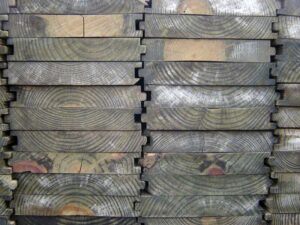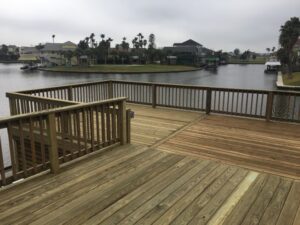How Wood is Pressure Treated: An In-Depth Look
Pressure-treated wood is a popular choice for various outdoor projects, thanks to its ability to resist decay and insects. But what exactly is pressure-treated wood, and how is it different from regular lumber? 
Understanding Pressure-Treated Wood
Pressure-treated wood is a type of lumber that has undergone a treatment process where chemicals are infused into the wood to protect it from decay and insect damage. This treatment process involves placing the wood in a vacuum and applying chemicals under pressure. The chemicals used can vary, but they are typically copper-based compounds that repel insects and inhibit fungal growth.
How Pressure-Treated Wood is Made
The process of pressure treating wood starts with selecting the appropriate type of wood, such as Southern Yellow Pine, Douglas Fir, or Western Red Cedar. These wood species are known for their durability and ability to absorb the treatment chemicals effectively.
Once the wood is chosen, it is transported to a treatment facility where it undergoes a series of steps to ensure proper absorption of the preservatives. The wood is first checked for moisture content to ensure it is suitable for treatment. If the moisture content is too high, the wood may not effectively absorb the chemicals.
Next, the wood is loaded into a large steel cylinder, known as a vacuum pressure vessel. The vessel is sealed, and air is removed through an industrial vacuum pump, which also pulls air out of the wood. This creates a vacuum environment that allows the preservative solution to penetrate deep into the wood cells.
After the vacuum stage, the cylinder is flooded with the preservative solution, and pressure is applied to force the chemicals further into the wood fibers. The specific cycle times and pressure settings are adjusted based on the desired retention levels and the type of wood being treated.
Once the treatment cycle is completed, excess solution is drained from the wood, and a final vacuum is run to extract any remaining preservative. The freshly treated wood is then placed on a drip-pad for 24 to 48 hours to allow any excess solution to drain off.
Types of Pressure-Treated Wood
Pressure-treated wood comes in different types, each with its own specific characteristics and uses. The three main types of pressure-treated wood are:
- Borate: Borate-treated wood is treated with water-based mineral salt solutions that protect against insects, mold, mildew, and fungi. However, constant exposure to wet conditions can wash out the treatment, reducing its effectiveness.
- Alkaline Copper Quaternary (ACQ): ACQ-treated wood is treated with a solution containing copper and ammonium alkyl. It is environmentally friendly and effective against rot and insects. However, it may change the color of the wood.
- Noncombustible: Noncombustible pressure-treated wood is treated to be resistant to fire. It is primarily used for commercial and industrial applications where fire resistance is crucial.
Suitable Uses for Pressure-Treated Wood
Pressure-treated wood is specifically designed for outdoor applications that require resistance to decay and insects. Here are some of the most common uses for pressure-treated w ood:
ood:
- Decks: Pressure-treated wood is an excellent choice for building decks, as it provides long-lasting protection against the elements.
- Fences: Fencing made from pressure-treated wood is durable and resistant to rot and insect damage.
- Playground Equipment: Pressure-treated wood is often used to build playground equipment, ensuring it can withstand constant use and exposure to the elements.
- Garden Beds: Raised garden beds made from pressure-treated wood are popular among gardeners, as they offer longevity and protection against rot.
- Retaining Walls: Pressure-treated wood is commonly used for constructing retaining walls, as it can resist the pressure exerted by the soil.
- Structural Framing: Pressure-treated wood is suitable for structural framing in buildings, providing strength and durability.
- Piers and Docks: While pressure-treated wood is not recommended for marine applications, such as piers and docks, special rot-resistant hardwood can be used instead.
It’s important to note that pressure-treated wood is not suitable for direct contact with food or animal feed. Additionally, it should not be burned, as the chemicals can vaporize and pose health risks.
Safety Considerations
The safety of pressure-treated wood has been a topic of concern in the past, particularly due to the use of arsenic-based treatments. However, since 2004, the use of arsenic in residential pressure-treated wood has been banned by the EPA. Today, pressure-treated wood is considered safe for most applications.
That being said, when working with pressure-treated wood, it’s recommended to take certain precautions. When cutting, sanding, or drilling the wood, wear a mask to avoid inhaling any potentially harmful dust or particles. It’s also advisable to work in a well-ventilated area to minimize exposure.
While pressure-treated wood is generally safe for residential use, it’s essential to handle and dispose of any leftover scraps properly. Do not burn pressure-treated wood, as this can release harmful chemicals into the air.
Maintaining Pressure-Treated Wood
To ensure the longevity and appearance of pressure-treated wood, regular maintenance is required. Here are some tips for maintaining pressure-treated wood:
- Sealing: Applying a water repellent or sealer can help protect the wood from moisture and prolong its lifespan.
- Staining: Staining pressure-treated wood can enhance its appearance and provide additional protection against UV rays and weathering. However, it’s crucial to allow the wood to dry completely before applying stain.
- Regular Cleaning: Periodically clean pressure-treated wood to remove dirt, debris, and mildew. Use a mild detergent and a brush or pressure washer to gently scrub the surface.
- Inspections: Regularly inspect pressure-treated wood for signs of damage, such as cracks, splinters, or rot. Promptly address any issues to prevent further deterioration.
